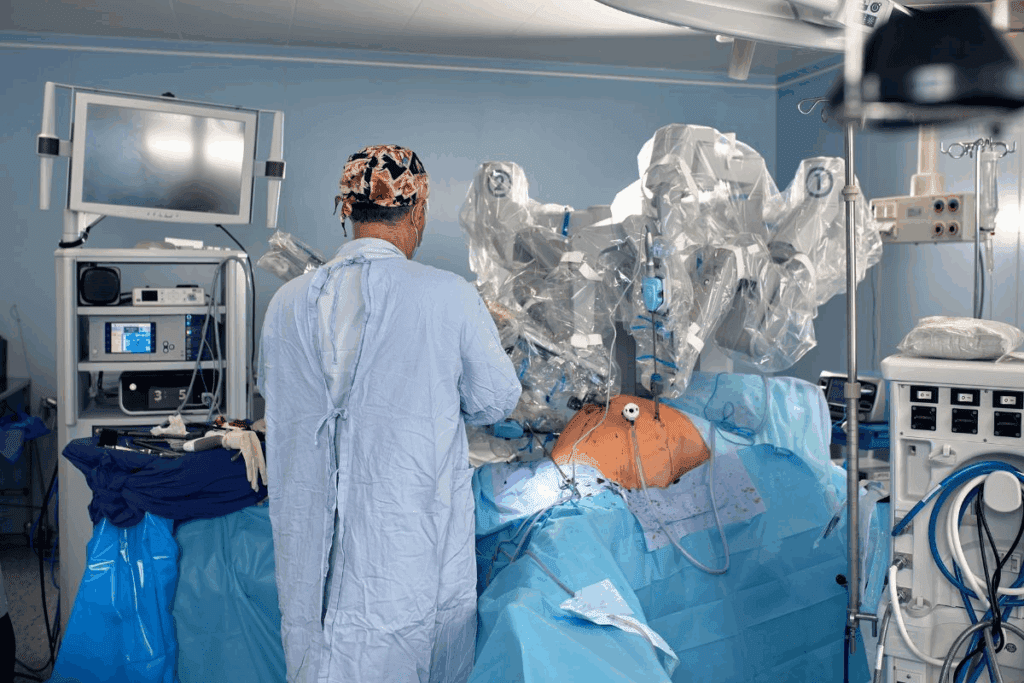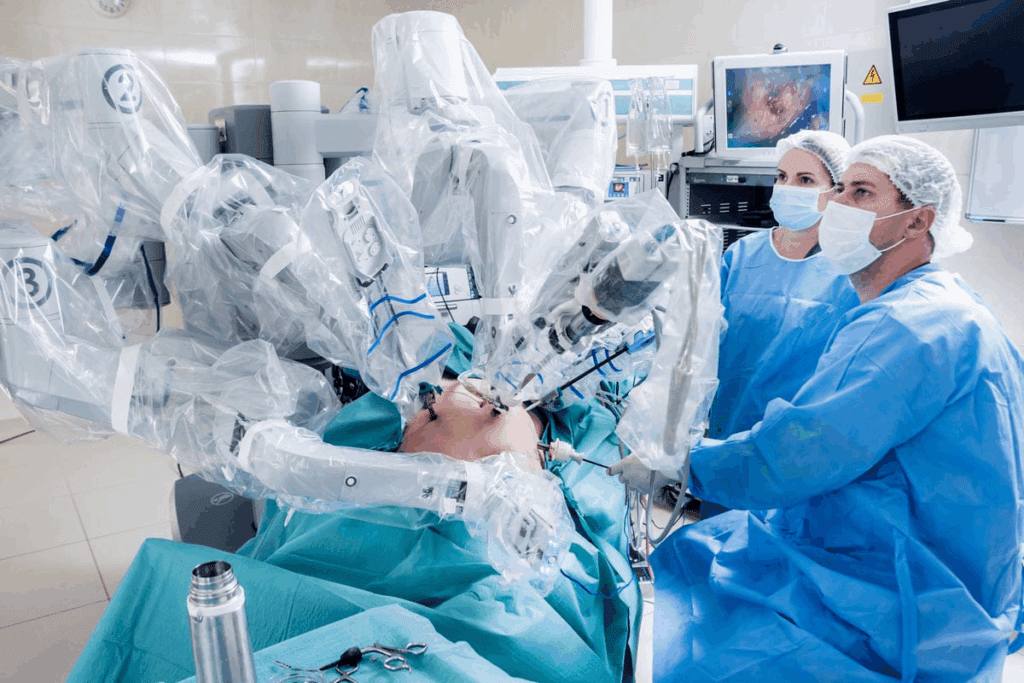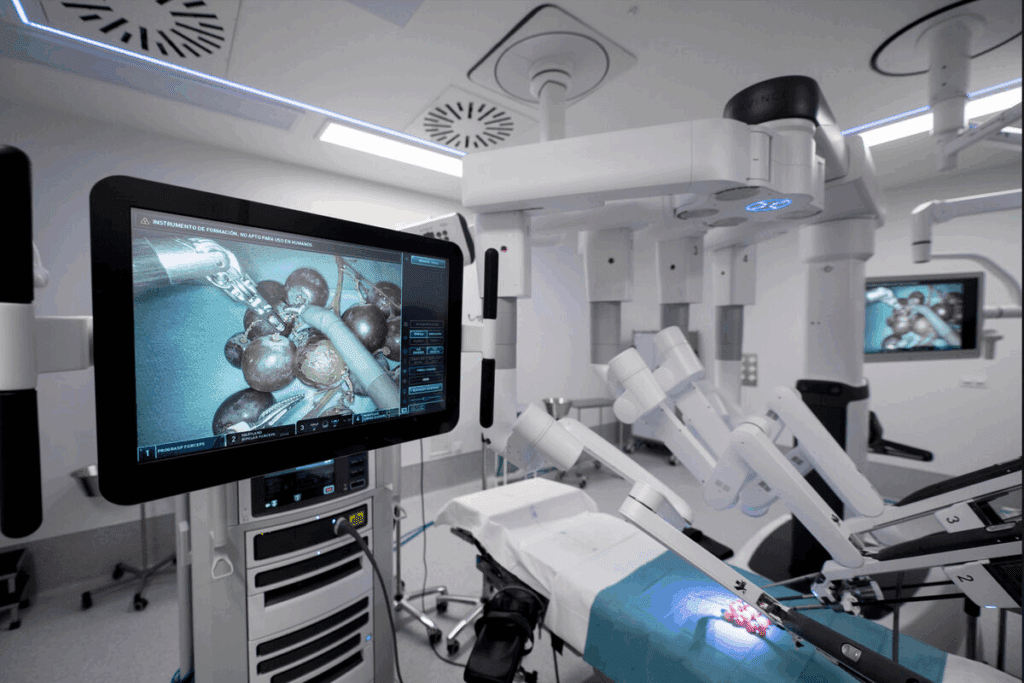Last Updated on November 27, 2025 by Bilal Hasdemir

Learn about the growing frequency of robotic surgery. This amazing technique is becoming more common. Get the latest usage data.
Robotic surgery is now a big part of healthcare, changing how surgeries are done. Some companies are reporting strong growth in robotic surgery products. This shows more doctors are using it in different medical fields.
The minimally invasive nature of robotic procedures means operations are more precise. This leads to less harm to patients and faster healing times. As the robotic system gets better, it’s being used more in medicine today.

The world of robotic surgery is changing fast. It’s making healthcare better by adding precision and control. More and more doctors are using it in their work.
How much robotic surgery is used varies a lot. North America and Europe lead because they have good healthcare and pay for it well. But, Asia-Pacific and Latin America are catching up fast. They’re spending more on healthcare and learning about robotic surgery’s benefits.
Things like who can use the tech, how much it costs, and if it’s approved affect how much it’s used. As these things change, more places will start using robotic surgery.
Robotic surgery is used differently around the world. In the United States, it’s common in many areas like urology and gynecology. In Europe, countries like Germany and the UK are leading. They have strong healthcare and do a lot of research.
In Asia, countries like China and India are using it a lot too. They have a lot of people and are building up their healthcare. But, it’s expensive and they need more trained doctors.

Robotic surgery has changed the game in surgery, thanks to tech improvements. It started with simple ideas and grew into a key part of surgery. This change has made surgeries better and safer.
The story of robotic surgery is one of quick progress and big leaps. It began in the late 20th century with the first systems. Key technological advancements have made it more precise, flexible, and controlled.
Robotic surgery’s adoption has seen many important moments. These moments show how it’s become a big part of surgery. Significant milestones include it being used in more areas and new platforms being developed.
Understanding robotic surgery’s history and milestones helps us see where it is now and where it’s going. With ongoing tech improvements, robotic surgery will keep getting better and more useful.
Robotic surgery systems bring new precision and control to surgeons. They change how complex surgeries are done. These systems are key in today’s surgery, beating old methods in many ways.
The Da Vinci Surgical System is a top choice worldwide. It’s known for its cutting-edge tech. This includes clear 3D views, precise tools, and an easy-to-use interface for doctors.
Key Features of the Da Vinci Surgical System:
While the Da Vinci leads, other robots also play big roles in surgery.
Notable Alternatives:
These systems keep getting better. They aim to improve patient results and let doctors do more surgeries with robots.
Robotic surgery is changing the medical field with its precision and versatility. As technology gets better, more procedures are being done with robots. This section will look at the most common robotic surgeries, focusing on urology, gynecology, and general surgery.
Urology is leading in using robotic surgery. Prostatectomies are a top robotic surgery. Robots help preserve nerves, leading to better results in continence and potency.
Other urological surgeries, like nephrectomies and pyeloplasties, are also done with robots. These surgeries have less blood loss, less pain, and shorter hospital stays.
| Procedure | Robotic Benefits | Outcomes |
| Prostatectomy | Precision, nerve preservation | Improved continence, potency |
| Nephrectomy | Reduced blood loss, less pain | Shorter hospital stay, quicker recovery |
| Pyeloplasty | Enhanced dexterity, visualization | Better success rates, fewer complications |
Robotic surgery is also key in gynecological oncology and other gynecological surgeries. Hysterectomies for various reasons are often done robotically. This method reduces blood loss and shortens hospital stays.
Other gynecological surgeries, like endometriosis resection and sacrocolpopexy, also benefit from robotic precision and visualization.
In general surgery, robotic procedures are becoming more common. This includes cholecystectomies and hernia repairs. Robots offer better precision and faster recovery times.
Even complex surgeries like gastric bypass surgery and colectomies are being done robotically. They benefit from better visualization and dexterity.
As robotic technology improves, it will be used in more general surgeries. This will give patients more options for less invasive surgeries with better results.
Robotic surgery is growing in healthcare, showing how it’s used in different areas. Some specialties use it more than others. This shows how robotic technology is changing surgery.
Urology leads in using robotic surgery, with many procedures done this way. This shows urology’s early start and ongoing innovation in robotic surgery.
Urology is a top user of robotic surgery. It lets surgeons do complex tasks with better precision and less harm. Key urology uses include:
Robotic surgery in urology helps patients recover faster and get better results.
Gynecology is also seeing more robotic surgery. It helps by cutting down on blood loss and pain after surgery. Common uses are:
More gynecology procedures are going robotic, showing a push for less invasive methods.
Cardiac surgery is starting to use robotic surgery, but it’s not as common yet. It could lead to smaller cuts and quicker healing. New uses include:
Robotic surgery in heart surgery is new but promising for treating heart issues.
Robotic surgery is growing fast in healthcare. It brings many benefits that change how surgeries are done and care is given.
Robotic surgery offers enhanced precision and control. It gives surgeons a clear, 3D view of the area being operated on. This makes complex surgeries more accurate.
The precise movements of robotic tools lower the chance of problems. It also leads to better results for patients.
Robotic surgery means reduced recovery times for patients. Its minimally invasive nature causes less damage and pain. This leads to faster healing.
Patients can get back to their daily lives sooner. This improves their quality of life.
Robotic surgery improves outcomes in complex cases. It offers better visualization and precision. This lets surgeons handle tough procedures with more confidence.
This results in better patient outcomes. There are reduced complication rates and better long-term results.
The benefits of robotic surgery are making it more popular. As technology gets better, we’ll see more uses of robotic-assisted surgery.
Robotic surgery is becoming more common. We need to look at how it affects patient satisfaction and health results. It’s important to know how this technology changes patient care.
Research on robotic surgery shows mixed results. Some studies say it leads to improved health outcomes because it’s more precise and less invasive. For example, a study in the Journal of Urology found robotic prostate surgery caused less blood loss and shorter hospital stays than traditional surgery.
But other studies found no big difference in health results between robotic and traditional surgery. A review in the British Journal of Surgery said robotic surgery might help patients recover faster. But it’s not clear if it’s always better for health outcomes.
Patient happiness is key when we talk about robotic surgery’s success. Patient-reported experience measures (PREMs) give us a good look at how patients feel about their care. Studies show patients who have robotic surgery often feel more satisfied because they have less pain and recover faster.
A study in the Journal of Robotic Surgery found patients who had robotic hysterectomy were more satisfied than those who had traditional surgery. This shows how important it is to listen to what patients say about their surgery.
In summary, while the health outcome evidence is mixed, patient feedback suggests robotic surgery makes patients happier. As this technology keeps growing, we need more research to fully understand its effects on health and happiness.
There’s a big difference in how academic and community hospitals use robotic surgery. This gap is seen in how often they use it, the types of surgeries done, and the results.
Studies show that academic hospitals start using new robotic surgery tech sooner than community hospitals. This is because academic places focus on research and training. For example, a study found that academic hospitals buy the newest robotic systems. This lets them do more complex surgeries.
“The use of robotic surgery in academic centers is for both patient care and training,” said a top robotic surgeon. “It improves care and helps train future surgeons.”
Community hospitals, on the other hand, might take longer to adopt robotic surgery. They often start with simpler surgeries like urology and gynecology. But, they’re catching up as they see the benefits like quicker recovery times and better results for patients.
The number of robotic surgery cases differs a lot between academic and community hospitals. Academic centers do more complex surgeries like heart and cancer surgeries. This is because they have specialized departments and get more referrals.
Even though there are differences, both types of hospitals are doing more robotic surgeries. As technology gets better and more data comes in, we might see more similarities in how they use robotic surgery.
Demographic factors greatly affect who can get robotic surgery. As robotic surgery becomes more common, there’s a growing concern about fair access to this technology.
Socioeconomic status is key in getting robotic surgery. Studies have shown that those with more money are more likely to get it. This is because of insurance and access to tech-equipped hospitals.
A study published in a medical journal found a big gap in access. Patients with private insurance were more likely to get robotic surgery. Those with Medicaid or no insurance faced a bigger hurdle.
These factors together decide if someone can get robotic surgery. For example, better education means patients are more likely to seek out advanced treatments.
Where you live also matters for getting robotic surgery. Urban areas have more access to hospitals with robotic tech than rural areas.
“The distribution of robotic surgery systems is not uniform, with a higher concentration in urban centers, creating a care access gap between urban and rural populations.”
This gap is made worse by robotic systems being mainly in big hospitals. These places are hard to reach for many, making access even harder.
Fixing these geographic issues is vital for fair robotic surgery access. Ideas like mobile surgery units or training for rural surgeons could help.
The world of robotic surgery is set for a big change with new tech coming in. As it grows, we’ll see some major trends in how robotic surgery is used.
New tech is ready to boost robotic surgery even more. Here are some big changes we can look forward to:
Robotic surgery’s use will grow in certain ways because of new tech and proof it works.
These changes will lead to better care and more efficient surgeries. The future of robotic surgery is bright, thanks to ongoing innovation.
Robotic surgery is changing healthcare, making surgeries more precise and quick. It helps patients recover faster and get better results in tough cases. As technology gets better, robotic surgery will help even more people.
Today, robotic surgery is moving towards less invasive methods. The Da Vinci Surgical System is a big step forward. Soon, more doctors will use robots in urology, gynecology, and heart surgery.
Robotic surgery is key to better healthcare, improving patient results and guiding surgery’s future. As doctors use new tech, more patients will benefit from robotic surgery.
Robotic surgery, also known as robot-assisted surgery, is a new way to do surgery. It uses a robotic system to help with the procedure. The Da Vinci Surgical System is a well-known example.
Robotic surgery is more precise and flexible than traditional surgery. It lets surgeons do complex tasks with better accuracy. This means less invasion and better results.
Robotic surgery has many benefits. It leads to faster recovery, less blood loss, and better results in tough cases. It also allows for more precise and controlled procedures.
Robotic surgery is used for many procedures. These include prostate, gynecological, and general surgeries. Examples are prostatectomies, hysterectomies, and cholecystectomies.
Robotic surgery is getting more common worldwide. But, its use varies by region and healthcare system. Academic hospitals and specialized centers lead in adopting robotic surgery.
Patient demographics play a role in access to robotic surgery. Socioeconomic factors and location can affect it. People in rural or underserved areas might find it harder to get robotic surgery.
The future of robotic surgery looks bright. Advances in technology will improve robotic systems and imaging. It’s expected to grow into new areas and specialties.
Like any surgery, robotic surgery has risks. These include complications and equipment problems. But, the benefits often outweigh the risks for many patients.
Robotic surgery often leads to better outcomes. It reduces morbidity and can improve survival rates. Studies and patient feedback show its effectiveness.
Subscribe to our e-newsletter to stay informed about the latest innovations in the world of health and exclusive offers!